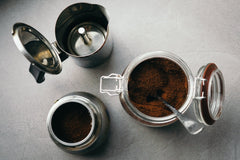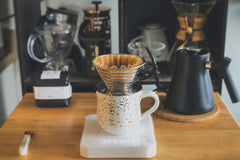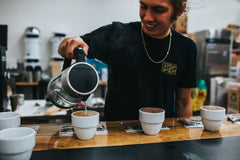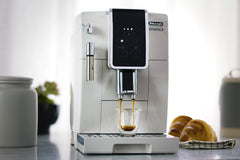
Welcome to the next step of your coffee journey: brewing at home.
By now, you’re familiar with the 10 Coffee Commandments, you’ve got your gear and your beans, and you’re ready to brew.
We’re here to help you with one of the most important questions of the coffee brewing process.
Table of Contents
- What Size Should I Grind My Coffee?
- Extra Coarse: Cold Brew Coffee
- Coarse Grind: French Press Coffee
- Medium-Coarse Grind: Chemex and Flat-Bottom Pour Overs
- Medium Grind: Drip Coffee Makers and Longer Brew Aeropress
- Medium-Fine: Cone-Shaped Pour Overs, Espresso and Aeropress
- Fine Grind: Moka Pot, Espresso and Shorter Brew Aeropress
- Extra-Fine Grind: Turkish Coffee
- How Does Grind Size Affect the Taste of Coffee?
- Blade vs. Burr Coffee Grinders
- FAQs About Coffee Grinder Sizes
What Size Should I Grind My Coffee?
There’s no “one size fits all” option for brewing delicious coffee. The size of your coffee grinds depends on the brew method you plan to use.
You can make the same kind of coffee using two different brew methods and have two completely different coffee tastes.
How you brew your coffee really is that important.
Therefore, the size of your grind is equally important. You don’t want to end up with coffee that’s over or under-extracted.
But we’ll get into extraction later. For now, let’s focus on the right grind size for your brewing method.
It’s important to stress how important it is to grind your beans directly before brewing. Just look at Coffee Cantata’s first rule for great coffee at home:
“For optimum flavor, you must buy whole beans and grind them directly before brewing” — Coffee Cantata
To determine your ideal coffee grind size, find your choice brewing method on the coffee grind chart and use that grind size when you brew.
| Coffee Brew Method | Coffee Grind Size |
| Cold brew, Cowboy | Extra coarse grind |
| French Press, Percolator | Coarse grind |
| Chemex, Flat-bottom pour-over | Medium-coarse grind |
| Cone-shaped pour-over, Drip Coffee, Aeropress | Medium grind |
| Cone-shaped pour-over, Aeropress | Medium-fine grind |
| Espresso, Moka pot, Aeropress | Fine grind |
| Turkish Coffee | Extra fine grind |
Surely you noticed some of the brew methods appear next to a few different grind sizes. We’re not trying to trick you, we promise. It’s just that the grind size for these methods varies depending on other factors like brew time.
So let’s break down each grind size and the intricacies of their corresponding brew methods.
Extra Coarse - Best for Cold Brew Coffee
An extra coarse grind will be about the size of rock salt.
This is the ideal size for making a strong, delicious batch of cold brew coffee.
The brew time for this method can last up to 24 hours, during which you’ll want your cold water to circulate through the coffee.
A finer grind clumps together when submerged in water, resulting in suboptimal extraction.
Cowboy coffee is a classic outdoorsy method of coffee brewing, which requires you to boil your water in a pot or kettle, then add the coarse coffee grounds to the hot water.
Again, water flow is key for this method, as well as the need for your extra coarse coffee grounds to settle to the bottom of the kettle before pouring.
Coarse Grind - Ideal for French Press Coffee
The perfect French press grind size is coarse enough for the water to flow freely during the recommended brew time and not pass through the filter screen on the plunger when you press down.
You’ll also want to grind coarse when using a percolator.
This method uses higher water temperatures than other methods, making it more susceptible to over-extraction, so you want to avoid grinding too fine.
Your coarse coffee grounds should be about the size of sea salt.
Medium-Coarse Grind - for Chemex and Flat-Bottom Pour Overs
This is where things start to get a little tricky.
Your medium-coarse grind will be similar in size to coarse sand. Not quite as coarse as a French press grind, but notably coarser than a medium grind.
This size is ideal for Chemex and flat-bottom pour-over brewers.
A Chemex filter is thicker than your standard paper cone-shaped pour-over filter, making a coarser grind necessary so the water can flow more freely and avoid over-extracting the coffee by increasing the brew time.
The same is true of flat-bottom pour-over brewers. The water flows slower than in their conical cousins, so a coarser grind is necessary.
Medium Grind - Best for Drip Coffee Makers and Longer Brew Aeropress
This grind is about the size of regular beach sand.
This grind is ideal for drip coffee makers.
Cone-shaped pour-over coffee makers also use the medium to medium-fine grind size. The finer grind causes water to flow more slowly through the filter, increasing the extraction time.
The size of your grinds will vary depending on your brewer, filters, and taste preferences, so you’ll need to experiment with your pour-over brewer to find the right size for you.
The medium grind also marks the first appearance of the Aeropress brewing method on the coffee grind chart.
Use medium-sized grinds in your Aeropress with a three minute or more brewing time.
Medium-Fine Grind for Cone-Shaped Pour Overs, Espresso and Aeropress
About the size of table salt, use a medium-fine grind in your cone-shaped pour-over brewer (e.g. Hario v60) or your Aeropress when brewing for two to three minutes.
Fine Grind - Perfect for a Moka Pot, Espresso and Shorter Brew Aeropress
The fine grind is your standard size for pre-ground coffee and is about the size of granulated sugar.
Use this size when making espresso or an Aeropress with a one to two minute brew time.
You’ll also want to grind medium-fine when using a Moka pot. The Moka pot is the closest you can get to making espresso without an espresso maker, which is a good way to remember how fine to grind your beans — finer than a regular coffee, but not quite an espresso grind.
Extra-Fine Grinds - Recommended for Turkish Coffee
You’ll really only need to grind your coffee into an extra-fine flour-like consistency when using the Turkish coffee method, and you’ll likely need a Turkish coffee grinder to achieve this extra-fine grind.
How Does Grind Size Affect the Taste of Coffee?

10 Best Coffee Subscription Boxes
When your coffee grounds are too coarse, you risk under-extracting the beans. This results in a sour, salty, acidic coffee taste.
On the flip side, over-extracting your beans by using coffee grounds too fine results in bitter, hollow coffee.
That’s why it’s important to use the right grind size for your method of brewing.
Of course, the coffee grind chart can only take you so far. You’ll need to do your own experimenting to perfect your coffee grinding and brewing.
Just remember, if your coffee is too sour, try grinding your beans a little finer next time.
Too bitter? Grind coarser.
After a few batches, you’ll have it down to a science.
If you’re interested in the science of it, check out Beanground’s more in-depth explanation of coffee acidity.
Since grind size is so important to your coffee’s taste, the type of coffee grinder you use can make all the difference.
We can break coffee grinders down into two categories: blade grinders and burr grinders.
So which should we choose?
Blade vs. Burr Coffee Grinders

Hario Skerton Ceramic Coffee Mill Hand Grinder (100g) Black
Any coffee expert will tell you a burr grinder, specifically a conical burr, is better than a blade grinder.
It all comes down to consistency in the grind.
By now, you know the size of your coffee grounds is extremely important to the brewing process.
Of course, that means you want all of your coffee grounds to be the same size. This is where a blade grinder falls short of the superior conical burr grinder.
A blade grinder is basically a glorified food processor, using blades to chop up the coffee beans and produce an uneven mess of coffee grounds. The fast-spinning blades also produce heat, resulting in overcooked coffee.
Conical burr grinders essentially crush the coffee beans into a consistent grind with no extra heat.
Your best bet for consistent freshly ground coffee is a conical burr.
>> Check out our full review of the best coffee grinders
FAQs About Coffee Grind Sizes
Get to Brewing
Now that you understand the coffee grind chart, you can start exploring and experimenting to find your ideal cup.
Sign up for a subscription to Nomad Coffee Club, and you’ll have enough beans to master every grind size and brewing method. Enjoy a different coffee every single month.







